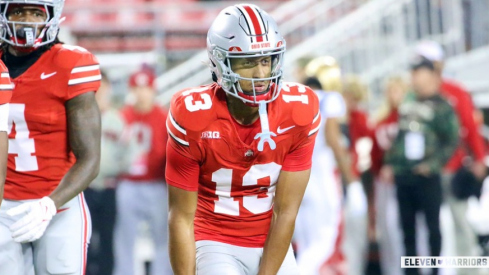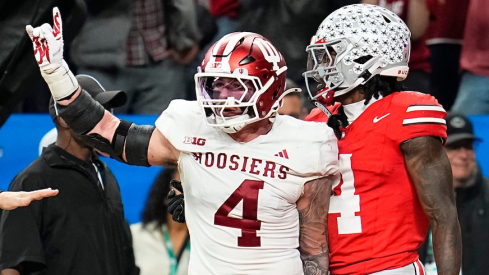
Clemson did not do anything fancy in rolling up 40 points and nearly 600 yards of offense.
The Tigers' game plan was to exploit the horizontal edge with wide receiver screens and jet sweeps, combined with the occasional power read for Tajh Boyd.
And the Tigers never abandoned that strategy because the Ohio State defense never forced them to. Boyd's average pass went 2.6 yards, yet the Tigers' first down drive rate was 86%.
An Ohio State defense that struggled on the edge throughout 2013 had no chance without Bradley Roby. And so the Buckeyes died by a thousand cuts.
Below I address the Clemson game plan, the Ohio State response (or lack thereof) and the Buckeyes' lack of fundamentally sound team defense.
Like Taking Candy From a baby
Clemson's offensive coordinator Chad Morris knew that his squad had an advantage with with wide receivers Sammy Watkins and Martavius against Ohio State's back seven. He also knew that the Buckeyes struggled all season with quick hitting screen plays. As a result, Clemson threw at least a dozen wide receiver screens, along with jet sweeps and flat routes attacking the edge.
Yet despite largely knowing what was coming, the Buckeyes could not stop it. Clemson's primary play was a flash screen to Watkins. As the outside receiver, Watkins faked up field and came back towards Boyd for the football, while the inside receivers stem blocked

Much has been made of the Buckeyes' corner depth in defending such plays. But the corner's job is to take on the blocker and force the play inside.
Ohio State's primary problem was not the corner depth but its inside pursuit. When Ohio State's defenses were playing at a high level under Jim Heacock they also used cover 3 and their corner depth was largely the same. But Ohio State's nickel, who is responsible for the wide side flat, quickly attacked wide receiver screens before the blocker could get in place. Recent Buckeye nickel defenders have recently struggled with this task. Von Bell, making his first start, was repeatedly blocked out of the play down field.
The problem was exacerbated by the Buckeyes' linebackers and safeties. All too often these defenders were hesitant in their reads, and once they diagnosed the play they failed to aggressively attack. The Buckeyes' weakness was exploited because Watkins is such a good athlete that once he got going he was able to gain chunk yards.
The Song Remains the Same
Clemson's continued success with its game plan meant that Morris did not stray far from the script. The Tigers interspersed edge plays with inside power runs to Boyd. Boyd was able to break several explosive plays because of the same pursuit issues. Linebackers were catching blocks down field instead of attacking the hole. And the safeties were hesitant to play downhill. It was not a good sign that Tyvis Powell, in his first start at safety, played more aggressively then three year starter CJ Barnett.
Boyd running was the primary source of the Clemson run game; otherwise the Buckeyes largely kept Clemson's ground game in check.
Beyond the quick game, Clemson's passing offense largely consisted of the occasional down field throw. The Tigers were never forced to work the ball intermediately over the middle, and Ohio State could not force the Tigers out of their comfort zone.
It was not necessarily for lack of trying. The Buckeyes played large amounts of quarter-quarter-half and cover 1 robber along with cover 3, and frequently brought corner blitzes. But whenever Luke Fickell brought pressure the blitzer did not get to the quarterback and it left Ohio susceptible to explosive plays. As a result, the Buckeye defense could not or would not attempt to take away what Clemson wanted to do.
Fundamentals
But as alluded to above, any scheme issues were secondary to technique deficiencies.
Below, Boyd hit Watkins for a 34 yard touchdown from a trips formation against the Buckeyes' quarter-quarter half.
Quarter-quarter-half meant that Ohio State played cover 4 to the trips. Many teams will check out of split safety coverage against trips, but if a defense stays in the coverage the trips-side nickel and linebacker must work in tandem with what is sometimes call banjo. The nickel takes the first out breaking receiver and the linebacker takes the second out breaking receiver, and vice versa.

As the play progresses with Clemson running four verticals, Von Bell must play man against Watkins down field and Perry must do the same with the slot receiver, with safety help over the top. But as the play commences, Perry does not re-route the slot receiver or mirror him down field. This forces CJ Barnett to cover the slot receiver, and the inside help Bell was expecting never materializes.


Such breakdowns bedeviled Ohio State throughout the 2013 season.
First things First
Concededly, the Buckeyes played a lot of young players on defense, a problem that was only exacerbated with the loss of Roby, Noah Spence, and Christian Bryant. But the problems did not improve as the year progressed. For example, the problems with linebacker zone coverage techniques was as evident against Clemson as it was against Wisconsin. Multi-year starters like Ryan Shazier and Barnett did not make up for this inexperience; to the contrary they were as liable to be hesitant in their reads, catch blockers, and overrun plays.
The Ohio State defense cannot perform at a high level until they correct issues such as coverage techniques and pursuit angles. Having an identity helps, in that it provides a set of principles that trickle through the program, allowing position coaches to install techniques for that identity. But at its core, the Ohio State defense is currently not fundamentally sound, which does not work with any scheme.

